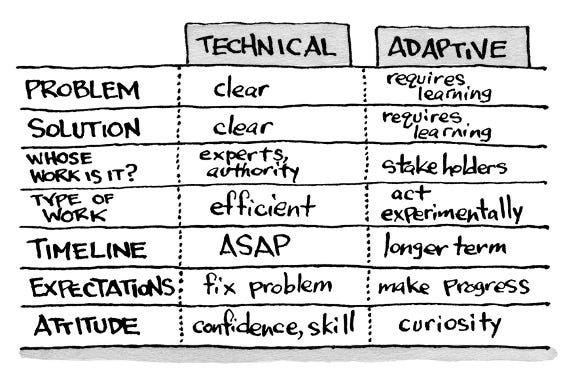Adaptive vs. Technical Problems
Adaptive leadership provides a model to think about and tackle complex problems. My study and understanding of adaptive leadership began for me at the Kansas Leadership Center (KLC), a place where the concept is deeply woven into the fabric of leadership development. KLC employs the adaptive leadership model as its foundational framework, aiming to empower leaders across Kansas (and the world) to navigate and address the complex challenges faced by organizations and communities. This model, a brainchild of Ron Heifetz and Marty Linsky of Harvard, offers a nuanced lens through which leadership can be understood and practiced, especially within the context of complex challenges[1].
Adaptive vs. Technical Work
Central to the adaptive leadership framework is the distinction between adaptive and technical work, a differentiation that demonstrates how to approach a challenge. To bring this distinction to life, let’s look at some examples.
During a game, a player hurts their ankle very badly. The athletic trainer says he is out but is unsure of the extent of the injury.
What do you do?
Pretty simple…the player goes to the doctor (the expert) to find out what is wrong and a plan for recovery. If the doctor has trouble diagnosing the issue, an ankle specialist will likely be called. Why? Because the specialist is the expert. This is a technical problem with a technical solution. Something happens, you find the expert, and the expert gives you the solution. It can happen relatively quickly, and the problem can be fixed.
Playing out this example, let’s say the player that was hurt was a sophomore and it was a career ending injury. Further, this player was the hardest worker, the best player, well liked, and a team leader. The team now must deal with not only the disappointment of the hardship and disappointment their friend is facing but also how to reorient their team and move forward. They must find new team dynamics and ways of interacting, new ways of playing the game without their best player, new leaders must emerge, and the list goes on and on.
This is an adaptive problem. Learning is required, the team must work together, there will be trial and error, and it will take a while. Will the issue ever be totally fixed? Probably not because their best player is gone. But they can make progress every day.
Below is a helpful chart from the Kansas Leadership Center showing the elements of a technical vs. adaptive challenge. This has been an important resource for me in diagnosing what is going on and what is needed within different situations. While this frame might not be helpful to some coaches, it can helpadministrators understand what is going on and help lead coaches through different situations.
A common mistake leaders make is they diagnose adaptive challenges as technical. For example, the team chemistry is bad on a team and the coach thinks that one player is the issue. They want to kick the kid off the team and assume that all their problems will be solved. Could this be true? Sure. However, my experience tells me this reaction from a coach is often simplistic, avoids taking on the deeper issues within a program, and often creates more unrest and distrust in a program. It is treating an adaptive challenge as a technical issue.
[1] Heifetz, Ronald A., and Marty Linsky. Leadership on the Line: Staying Alive through the Dangers of Change, 2. Harvard Business Review Press, 2017.
Things That Are Making Us Think
Once again from ——peer leadership is among the most difficult types of leadership there is. Check out this Harvard Business Review article about Tom Brady’s thoughts on leading teammates.


























